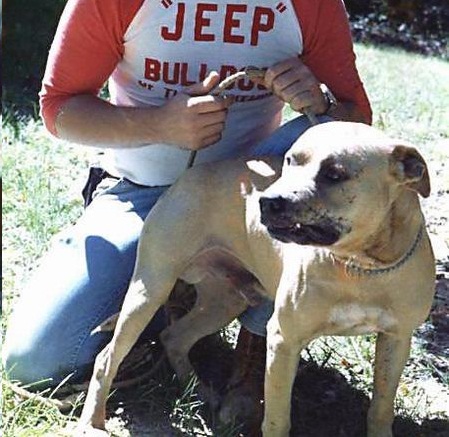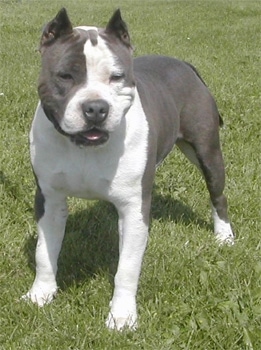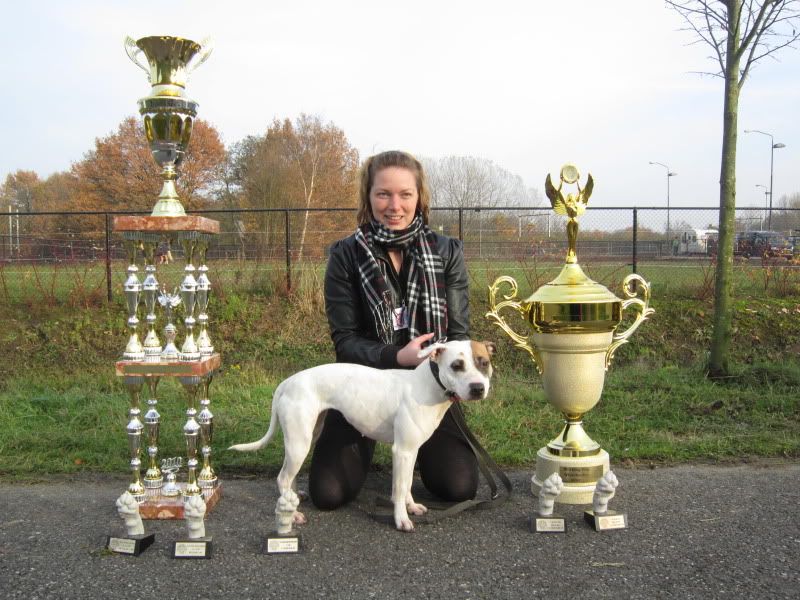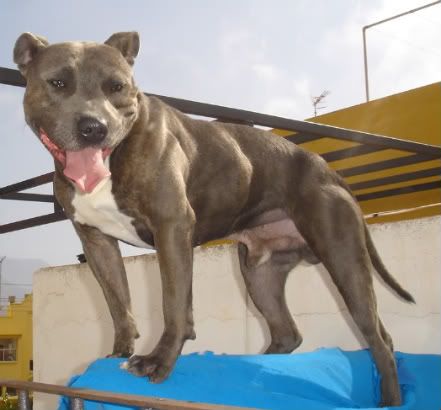First of all, there is no such breed as a "pit bull". "Pit bull" is a blanket term that can cover several different breeds that all look similar, but most people don't know the difference. And the media LOVES this fact, they can stir up craze about "pit bull" attacks about almost any dog, whether it's a true American pit bull terrier (the only REAL pit bull in my opinion) or not. Unfortunately, this feeds right into Breed Specific Legislation (BSL) so it's important for people to understand what is a "pit bull" and what is not.
The breeds most commonly referred to as "pit bulls" are: the American pit bull terrier (APBT), the American Staffordshire terrier (AmStaff), the American Bully (AmBully), the Staffordshire bull terrier (Staffy), and sometimes even the American bulldog (AB).
Allow me to demonstrate the difference...
First, we'll begin with the American pit bull terrier, the TRUE "pit bull". It's the breed that was developed over 100 years ago from the bull terrier types in England. They were brought over and bred for one particular reason - to be the ultimate warrior and canine athlete. They became the American pit bull terrier, bred for sport and performance, not looks. Generally between 25-60 pounds, amazing abilities, wonderful temperament towards people, and an aggressive disposition towards other animals. They were bred to fight other dogs in particular, but also were used to hunt, to watch over the family (particularly the children), and even served as war heroes and service dogs. They are good, small to medium-sized, American-bred family dogs and gladiators. Here are some pictures of some American pit bull terriers:
Ok, so now for the American Staffordshire terrier. They originally began as APBTs, but were split off by the American Kennel Club (AKC), basically, since the AKC would not register the APBT. Thus the American Staffordshire terrier was created in name only at first, using APBTs. However, over a short amount of time, the AmStaff and the APBT became two completely different breeds. One bred for looks and to prance around a show ring (the AmStaff) and the other still bred for performance and sport (the APBT). This not only changed how they looked, but also their temperament. The AmStaff became less dog aggressive. But unfortunately, as happens with most AKC dogs bred for the show ring, genetic health issues began to spring up: heart problems, ataxia, hip dysplasia, etc. They are generally more blocky in style and shape and tend to be heavier. So even though the AmStaff and the APBT began as the same breed, they are no longer the same at all. Now this is not to say there aren't good AmStaffs. There are plenty athletic and useable/working AmStaffs, but in general, they're bred to be handsome. Here are some pictures of some AmStaffs:
Now for the American Bully. The AmBully was originally created from the AmStaff. It is a conglomerate of mixes over a relatively short and recent time, including different breeds of mastiff, the APBT, the AmStaff, and in some cases, even English bulldogs. The American Bully was created basically for color and size. It is a designer breed that many like to pass off as an APBT to look tough or cool. The most popular color within the breed is blue, although recently other colors are more commonplace. American Bullies were created to fit a growing trend, particularly within the hip hop world and today's youth. Unfortunately, their popularity has risen to such a high state that when the general public hears the words "pit bull", the American Bully is the image they think of in their minds. This is unfortunate because the APBT gets the blame for the AmBullie's short-comings. Since AmBullies have been bred solely based on color and size, the more important aspects of dog breeding, such as health and temperament, have fallen by the wayside. In general, AmBullies are unhealthy, unathletic, and many have unstable temperaments (stemming from the mix of animal aggressive and human aggressive breeds and poor breeding practices). However, this said, some more well-bred AmBullies can excel at such things as weight pull competitions and even personal protection work. There are several different types of AmBully now varying in shape and size, but almost always strictly for looks and whatever trend is popular. Here are some pictures of different AmBullies.
Staffordshire bull terriers are another breed to discuss. Basically, they are descended from the same dogs as the APBT, but stayed in a separate gene pool since they were mostly limited to the United Kingdom. Unfortunately, over the years Staffies have undergone many different breeding practices that leave them so varied in size and shape that there is a similar split to the AmStaff vs. APBT predicament. The Kennel Club (KC) type Staffs are shorter, stockier built dogs than the working type Staff, which is a more lean and slightly taller version, very similar to the APBT. The working type Staffs have had to fulfill the role vacated by the APBT, since APBTs are outlawed in the UK. This leaves the show types to continue on a downward spiral away from the breed's original standard. However, there are still breeders who strive to continue breeding the working type Staffs. Here are some pictures of different Staffies. You can clearly see the difference between the show type and the working type.
Working type:
Show Type:
Breeds such as the American bulldog, the Presa Canario, the Dogo Argentino, and other breeds and mixes are also often confused for "pit bulls". Here are some pictures...
The American bulldog:
The Presa Canario
The Dogo Argentino
Even such breeds as Rottweilers, Boxers, and Labrador Retrievers have been confused as "pit bulls". The media uses this to their advantage to gain ratings for spouting Pit Bull Attack! all over the place. This is very unfortunate. And the general public will believe them, mostly because they do not even know what a true "pit bull" is. So I wrote this in an attempt to educate. For all these different breeds I've talked about are usually easy to recognize with a little time spent looking at the different kinds. But there is such a large gray area. The breeds can be mixed together or, due to overbreeding, be so far from the standard that it's really hard to tell which is which without actually looking at a pedigree. It's even more complicated because many of the different registries will still register an AmStaff as an APBT or an American Bully as an APBT. It is a terribly unfortunate situation with no remedy in sight for the near future. However, the more we educate people, the more of a chance we have of helping our beloved breeds.
As an important note following this, I would like to state that not all dogs fit the profile within their breed. There are always exceptions to the "rule". Also, I gave this information in the most general of terms as a basic run-down for readers. There is much more to each breed than stated, however time and space is limiting. I encourage everyone to do some of your own research if you want to know more specifics about each breed. And if you choose to do so, do so carefully, as there is a lot of misinformation out there.


















Hopefully alot of people will be able to read this, great info!!
ReplyDeleteI LOVE this Lj, you and Disco did a fabulous job presenting basic and truthful information to help break apart common misconceptions.
ReplyDeleteVery nicely put! Thank you.
ReplyDelete